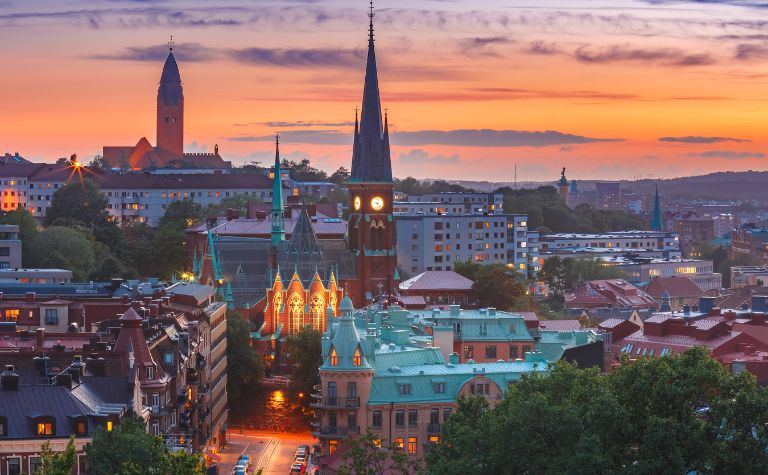Are you exploring Swedish culinary traditions? The following summary provides an enticing snapshot of what constitutes a typical lunch in this Nordic nation.
From grand feasts to simple, homely fare, Swedish lunchtime traditions are bound to pique your culinary curiosity.
Traditional Swedish lunches offer a blend of rich culinary experiences. From the multi-course Smörgåsbord to simple open-faced sandwiches, called Smörgås, and hearty home-cooked meals known as Husmanskost, Swedish cuisine truly caters to all tastes.
What foods are associated with traditional Swedish lunches? Which dishes are part of modern lunchtime trends in the country? Do Swedes eat a lot of meat? Is vegetarianism on the rise?
Keep reading to learn the answers to these questions and others.
Also, see Why Do Swedes Have Lights in Their Windows? to learn more.

Traditional Swedish Lunches
If there’s one aspect of Swedish culture that resonates worldwide, it’s the country’s unique and varied cuisine, especially when it comes to lunchtime.
Traditional Swedish lunches offer a glimpse into the nation’s history, geography, and even the local climate.
Here are some iconic meals and dishes one might find on a Swedish lunch table.
A crucial part of Swedish food tradition is the Smörgåsbord.
This multi-course meal is more of a feast, featuring a range of dishes like pickled herring, liver pate, cheeses, and crispbreads.
One might also find gravlax, a dish consisting of salmon cured in salt, sugar, and dill.
The Smörgåsbord is all about variety, and it’s a fantastic way to sample a little bit of everything that Swedish cuisine has to offer.
Next on the list of traditional Swedish lunches is the Smörgås, or open-faced sandwich.
Unlike the typical sandwich, a Smörgås consists of just a single slice of bread topped with various ingredients.
Common toppings include cold cuts, cheeses, or spreads, adorned with vegetables, herbs, and other accompaniments.
A classic Smörgås could be topped with Swedish meatballs and lingonberry jam, for example, while a more upscale version might feature smoked salmon and fresh dill.
Household Food
Husmanskost, which roughly translates to “household food,” represents Swedish home-cooked meals. This type of food is generally straightforward and hearty, perfect for a fulfilling lunch.
One typical Husmanskost dish is köttbullar, or Swedish meatballs, often served with potatoes, lingonberry jam, and perhaps a cream sauce.
Another common dish is raggmunk, or potato pancakes, usually served with pork and lingonberries.
Pea soup, or ärtsoppa, often paired with pancakes and lingonberry jam, is another lunch staple, particularly on Thursdays, following an old tradition.
Finally, given Sweden’s extensive coastline and abundance of lakes, it’s no surprise that seafood plays a significant role in the country’s lunch culture.
Besides the pickled herring and gravlax mentioned earlier, dishes like fish balls, smoked eel, and crayfish are also popular choices.
In essence, traditional Swedish lunches serve as a delightful medley of the nation’s rich culinary heritage.
From communal feasts like the Smörgåsbord to the simplicity and comfort of Husmanskost, there’s something to satisfy every palate.

Modern Trends in Swedish Lunch Habits
While traditional Swedish lunches continue to be savored across the country, contemporary Swedish lunch culture has not been immune to the global influences and trends sweeping across the culinary world.
Here are some of the modern tendencies shaping what Swedes eat for lunch today.
International Food
International cuisine has made a significant impact on Swedish lunches, reflecting Sweden’s multicultural society.
One can now find a diverse array of restaurants and cafes serving dishes from all corners of the globe.
Italian pastas, American burgers, Middle Eastern falafels, and Asian noodle dishes are just a few examples of the global flavors that have found a place in the Swedish lunch scene.
Concurrently, there’s been a growing popularity of salad bars and health food cafes, responding to the global trend toward healthier eating habits.
Whether it’s a well-stacked salad bar at the local grocery store or a specialized cafe serving smoothie bowls, avo toasts, and quinoa salads, Swedes are increasingly opting for nutritious, well-balanced meals that don’t compromise on taste.
Vegetarians trends
Similarly, the rise of vegetarian and vegan options has significantly impacted modern Swedish lunch habits.
Plant-based eating is increasingly mainstream, and restaurants across the country are rising to the challenge by offering innovative and flavorful vegetarian and vegan dishes.
From vegan versions of traditional Swedish meatballs to inventive plant-based creations, the options for meat-free lunches in Sweden are continuously expanding.
Lastly, the concept of ‘lunch specials’ or ‘dagens rätt’ in Swedish restaurants is another modern trend.
These daily specials, usually served at a lower price, have become a common way for Swedes to enjoy a variety of meals throughout the week.
The specials often reflect the season, making use of fresh, locally available ingredients and adding another layer of diversity to the lunch offerings.
According to a 2019 survey by Demoskop, an independent Swedish market research company, approximately 10% of the Swedish population followed a vegetarian or vegan diet.
It also reported a rising trend, especially among young people.
Furthermore, Sweden has been recognized for its proactive approach to encouraging more sustainable, plant-based diets.
For example, the city of Malmö won the United Nations’ ‘Policy Leadership Award’ in 2017 for its efforts to promote vegetarian and vegan food.
In conclusion, modern Swedish lunch habits encapsulate a blend of international influences, health-conscious choices, plant-based alternatives, and seasonal variety.
This evolution of lunch culture in Sweden demonstrates the country’s culinary dynamism while still remaining true to its traditional roots.

Experience Swedish Lunches
As we’ve explored, Swedish lunches, steeped in tradition and embracing modern influences, offer a window into the heart of Swedish culture.
From the communal and diverse Smörgåsbord to the comforting dishes of Husmanskost, and from international influences to the rise of health-conscious and plant-based meals, the Swedish lunch scene is both diverse and exciting.
The significance of these meals extends beyond their ingredients and preparation methods.
They offer a glimpse into the history of the country, the regional variations, and the evolving lifestyle of its people.
They symbolize the Swedish values of communal dining, respect for nature’s bounty, and an openness to new ideas and cultures.
As our culinary journey through Sweden concludes, it’s clear that Swedish lunches, whether traditional or modern, provide a delightful mix of flavors, textures, and experiences.
It’s an invitation not just to taste, but to savor and appreciate the richness of Swedish culinary heritage and the exciting trends shaping its future.
In the end, the enjoyment of Swedish cuisine is not just about nourishing the body, but also about enriching the soul.
Whether you’re in Sweden or preparing Swedish dishes at home, each meal can be a celebration of this wonderful Nordic culture. So next time lunchtime rolls around, why not try a taste of Sweden?
